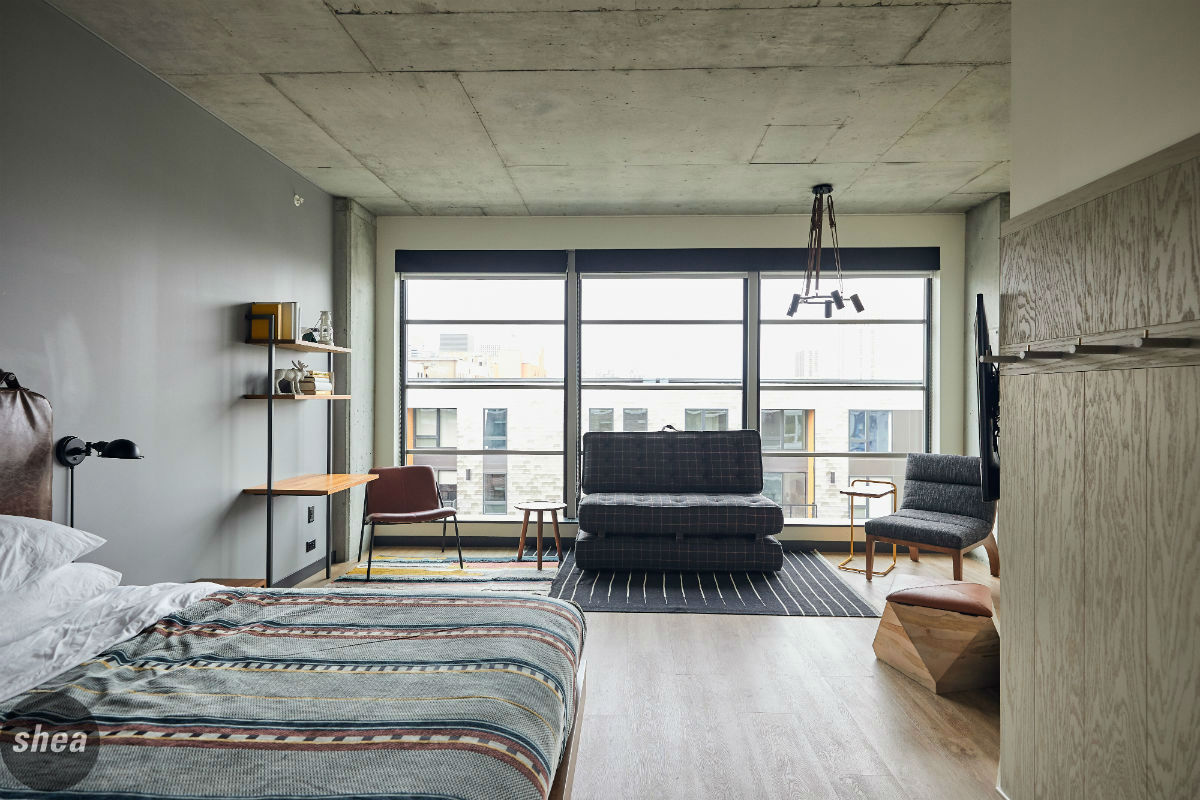At Shea, we pride ourselves on staying on top of what’s happening in design news. It helps us keep tabs on what’s fresh, inspiring, and happening in the world—and we make a few headlines of our own, too. Here are some recent articles delving into design, experience, and what’s buzzing in our community:
“The Future of Hotel Design” – New York Times:
This article dives into what hotel design could look like post-COVID, as hotels continue their opening plans in anticipation of a tourism swell once travel is widely safe again. To make guests feel safe and confident coming back, several innovations will become the norm—including contactless and touchless room controls, pop-up outdoor dining and robotic servers, outdoor-inspired décor in lobbies and dining spaces, guest rooms designed to have everything that guests need (versus the third-space common areas that have been popular recently), and mobile hotel rooms—taking the hospitality experience out of the hotel and on the road in vans and RVs.
“Coming Soon to the North Loop: AxeBridge Wine Co.” – Shea:
The Star Tribune piece on the forthcoming AxeBridge Wine Co., designed by Shea and set to open soon in the North Loop.
“McDonald’s, Chipotle, and Domino’s Are Booming During Coronavirus While Your Neighborhood Restaurant Struggles” – Wall Street Journal:
With the pandemic era closing in on seven months, this piece looks at how large operators are adding customers while local restaurants are forced to fold—due in no small part to their advantage in leverage, capital, and experience. The article includes year-over-year graphs for sales, employment, and more, as well as diagrams and notes on changes that fast-food and quick-service restaurants are planning to make in the long term post-COVID. It also digs into expansion, and why some brands are choosing now to get more aggressive while some are pulling back, and the struggles that local restaurants have even once they’ve reopened.
“Workplace Design: Bringing the Indoors Out” – Work Design:
In this story, a handful of design experts speak on how companies can work to build their spaces from the inside out—bringing elements that typically are used inside an office into the outdoors to promote fresh air and natural settings. With smaller indoor footprints and a natural draw to the outdoors post-COVID, the outdoor office will experience a boom as it’s seen as a healthier, more natural alternative to the conventional office space. Biophilic design indoors will also increase, but (despite challenges like inclement weather, acoustics, allergies, etc.), providing access to the outdoors with the comfort of the indoors will be huge—but will require some creative design solutions to make the idea work. This article also goes into a few ways to retrofit existing spaces to bring in this trend without a complete overhaul, from redesigning furniture to blend with a natural environment to embracing natural light and creating indoor conservatories and greenhouses.
“Restaurants Prolong Outdoor Dining With Igloos, Heaters” – Wall Street Journal:
The Wall Street Journal delves into how restaurants are reinventing themselves for winter, adding heaters and other fixtures to draw diners to outdoor tables to try to keep bolstering their already-modest revenue stream. Heated igloos and retractable shades are a start, and are being employed by ninetwentyfive in Wayzata. Restaurateurs are hoping to extend patio dining into November, but worry that it can’t be a primary business driver. Heaters can be expensive, but the price may be recouped this year if enough people want to eat outdoors. Cities and states continue to shift occupancy limits and rules for both indoor and outdoor dining, and restaurants are hoping to break even at best until they have to close their patios.
“2021 Foodservice Industry Forecast” – Foodservice Equipment & Supplies:
Amidst a tumultuous time, FES releases their annual report looking forward into the next year. With legislative and healthcare concerns fueling uncertainty, spending will likely be down into early next year. The first quarter of 2021 will likely be tough, but industry performance is likely to grow as the year goes on. Local economies will vary based on tourism, weather, population, and how the virus has affected them, as well as how state and local governments are handling reopening—but it’s likely that patrons will continue to support local as long as restaurants make it possible and feeling safe.
“A Looming Menace for Restaurants: Winter Is Coming” – Eater:
Eater Detroit explores how the creeping cold in the Midwest will affect restaurants in a COVID era, and how they plan to adapt as outdoor seating becomes less plausible. Some are worried about the holidays and that they won’t be able to fill the coffers this year. Others are investing, albeit hesitantly, by adding heaters and building permanent outdoor winter spaces, including igloo domes (although these are controversial in terms of disease transmission). And still more are focusing even more attention on family-style meal kits, takeout, and delivery, plus additional options like online meal classes and selling provisions. With less money coming in and the cost of doing business higher than ever, restaurateurs are looking for financial relief from the government as the only thing to really help.
“The Grocer’s Table Named Minnesota Monthly’s Best New Restaurant” – Shea:
Minnesota Monthly’s Best New Restaurants list, honoring those that have opened and persevered during the pandemic. The Grocer’s Table takes top spot, and Baldamar also gets a nod.
“On the Hunt for Office Space, Companies Stay Low to the Ground” – New York Times:
The Times examines the rise of “groundscapers,” office buildings with extensive square feet spread over a few stories, and their desirability during the pandemic. Low-rise buildings reflects evolving views over gathering in office spaces, enabling all employees of even large companies to work on a single level. And in the pandemic era, it eliminates the issues of elevators and limited entrances. Of course, these buildings take up significantly more ground space and are often relegated to the suburbs, city outskirts, or corporate campuses, in areas that lack the exciting urban vibrancy that skyscrapers are known for.
“What Even Are Those Outdoor Dining Bubbles?” – Grub Street:
We’ve been hearing a lot about outdoor dining “igloos” or bubbles, but Grub Street breaks down everything you really need to know about them. From cost to what they’re made of, from why they exist at all to who’s using them—and, most importantly, whether they’re actually built for pandemic safety and what needs to happen to keep them sanitized.
October 23, 2020
Shea Links: October

